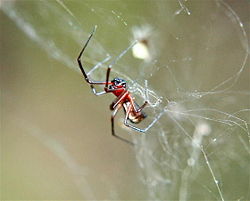
Bowl and doily spider
Encyclopedia

Species
In biology, a species is one of the basic units of biological classification and a taxonomic rank. A species is often defined as a group of organisms capable of interbreeding and producing fertile offspring. While in many cases this definition is adequate, more precise or differing measures are...
of sheet weaver found in North and Central America
Central America
Central America is the central geographic region of the Americas. It is the southernmost, isthmian portion of the North American continent, which connects with South America on the southeast. When considered part of the unified continental model, it is considered a subcontinent...
. It is a small spider
Spider
Spiders are air-breathing arthropods that have eight legs, and chelicerae with fangs that inject venom. They are the largest order of arachnids and rank seventh in total species diversity among all other groups of organisms...
, about 4 mm (0.2 inch) long, that weaves a fairly complex sheet web system consisting of an inverted dome shaped web, or "bowl", suspended above a horizontal sheet web, or "doily", hence its common name. The spider hangs from the underside of the "bowl", and bites through the web small flies, gnats and other small insects that fall down into the non-sticky webbing. The webs are commonly seen in weedy fields and in shrubs, and may often contain both a male and a female spider in late summer - like many linyphiids, Frontinella may cohabitate for some time.
The scientific name F. pyramitela is commonly seen, but this is a junior synonym.


